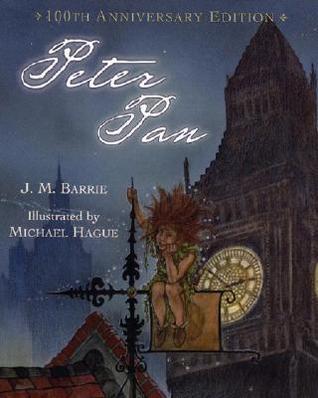
Introduction
J.M. Barrie’s Peter Pan is a beloved children’s novel that transcends generations. First published in 1904, the story captures the magic of childhood and the allure of a world untouched by time. It follows the adventures of Peter Pan, a mischievous boy who can fly, and the Darling children – Wendy, John, and Michael – as they embark on a fantastical journey to the mythical Neverland.
Main Characters: A Gallery of Dreams and Nightmares
- Peter Pan: The eternal boy, Peter Pan, embodies the carefree spirit of childhood. He can fly, never ages, and leads a band of Lost Boys who live eternally young in Neverland. However, Peter is also self-centered and averse to responsibility, highlighting the potential downsides of perpetual youth.
- Wendy Darling: The eldest Darling child, Wendy, possesses a nurturing personality and a motherly instinct. She longs for adventure but also feels a responsibility towards Peter and the Lost Boys. Wendy’s character arc reflects the transition from childhood to adulthood, where imagination blends with practicality.
- Captain James Hook: The fearsome pirate captain with a metal hook for a hand serves as the antagonist. He is obsessed with revenge against Peter Pan and represents the adult world’s order and rules, contrasting Peter’s carefree spirit.
- The Lost Boys: A group of boys who have fallen out of their prams and are forever lost at home. They yearn for a mother figure and idolize Peter as their leader. The Lost Boys represent a collective longing for a carefree childhood devoid of responsibility.
- Tinker Bell: A tiny fairy with a jealous streak, Tinker Bell acts as Peter Pan’s loyal companion. She is responsible for sprinkling pixie dust that allows the children to fly. Tinker Bell embodies the capricious nature of childhood friendships.
The characters in Peter Pan are more than just fantastical figures; they represent the complex emotions and inner conflicts associated with growing up.
Plot: A Flight to Neverland and Back
The central conflict of the story arises from the opposing desires of the characters. Peter Pan desires eternal youth and freedom from responsibility, while the Darling children grapple with the allure of Neverland and the pull of home and family.
The plot unfolds as Peter Pan whisks Wendy, John, and Michael away to Neverland, an island where children never grow up. There, they encounter mermaids, pirates, and an array of fantastical creatures. However, the island also holds dangers, including battles with Captain Hook and his crew.
As the story progresses, Wendy begins to yearn for her parents and the comforts of home. Peter, however, remains resistant to growing up. The climax arrives with a thrilling battle between Peter Pan and Captain Hook, culminating in the defeat of the pirate captain.
The resolution sees the Darling children returning home, forever changed by their adventures. Wendy assumes a more mature role, while Peter returns to Neverland, forever seeking new companions to join him in his eternal youth.
Setting: The Enchantment of Neverland
Neverland, the mythical setting of Peter Pan, is a key element of the story. This island, suspended somewhere between reality and imagination, is a place where children never age and wild adventures abound. The setting acts as a metaphor for the carefree nature of childhood, untouched by the constraints of time and responsibility.
However, Neverland is not a perfect utopia. It holds dangers like the ticking crocodile and the constant threat of Captain Hook. This duality reflects the complexities of childhood, where wonder and fear often coexist.
Themes: Beyond the Second Star to the Right
Peter Pan explores several universal themes that resonate with readers of all ages.
- Childhood and Innocence: The story celebrates the boundless imagination and carefree spirit of childhood. Through the characters’ adventures, Barrie emphasizes the importance of play and the power of imagination in shaping our lives.
- The Loss of Innocence and Growing Up: The novel also delves into the bittersweet reality of growing up. As the Darling children return home, they carry the memories of Neverland but must also face the responsibilities of adulthood. The story portrays the process of maturation as a necessary, if melancholic, journey.
- The Power of Imagination: Peter Pan highlights the transformative power of imagination. The ability to believe in the impossible allows the characters to fly and experience fantastical adventures. This theme encourages readers to embrace their own imaginations and explore the possibilities beyond the ordinary.
The recurring motif of flight serves as a symbol of freedom and the ability to transcend limitations. By sprinkling pixie dust, Peter Pan grants the Darling children the ability to fly, representing the liberation from the constraints of reality.
Author’s Narrative Style: A Whimsical and Nostalgic Tone
J.M. Barrie’s writing style is characterized by a whimsical and nostalgic tone. He employs vivid imagery and descriptive language to create a magical atmosphere. The author’s use of simple yet evocative language makes the story accessible to children while also resonating with adults.
Author’s Point of View: A Third-Person Perspective
The story is narrated from a third-person omniscient point of view, allowing the author to delve into the thoughts and feelings of various characters. This perspective provides a broader understanding of the story’s events and the motivations of the characters.
Personal Reflection: A Timeless Tale of Childhood and Loss
Peter Pan is a timeless classic that continues to capture the hearts of readers. Its exploration of childhood, imagination, and the bittersweet nature of growing up remains relevant today. The story’s enduring appeal lies in its ability to evoke nostalgia and a sense of wonder.
The theme of the loss of innocence is particularly poignant in the modern world, where children are often burdened with adult responsibilities. Peter Pan offers a nostalgic escape to a world where imagination reigns supreme.
Conclusion
Peter Pan is a captivating tale that invites readers to embrace their inner child. Its timeless characters, magical setting, and powerful themes continue to inspire and enchant. As we grow older, we may leave Neverland behind, but the spirit of adventure and the belief in the impossible remain within us.


